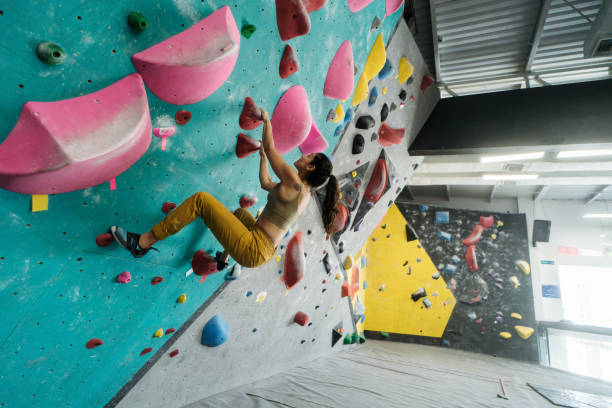Welcome to Rock Climbing 101: your ultimate beginner’s guide to the vertical world. From essential gear to safety tips, this article provides everything you need to know to embark on your rock climbing journey confidently and excitedly.
Rock climbing captivates the hearts and minds of adventurers for numerous reasons, each as compelling as the next. The challenge inherent in rock climbing appeals to those who crave physical and mental stimulation. Scaling vertical cliffs or navigating intricate routes demands strength, agility, problem-solving skills, and mental focus. The allure of overcoming obstacles and pushing personal limits draws individuals seeking a thrilling and rewarding challenge. With each climb, climbers experience a profound sense of accomplishment and empowerment, fostering self-confidence and resilience in adversity.

Climbers find solace in the awe-inspiring landscapes, serene environments, and breathtaking vistas that serve as the backdrop for their adventures. Whether scaling granite walls in Yosemite Valley, exploring limestone crags in Thailand, or bouldering amidst the towering peaks of the Alps, climbers immerse themselves in the beauty and majesty of the natural world. Through rock climbing, individuals develop a deeper appreciation for the environment, cultivating a sense of stewardship and conservation as they explore and protect the planet’s most precious landscapes.
Rock climbing fosters a vibrant and supportive community united by a shared passion for adventure and exploration. Climbing gyms, outdoor crags, and climbing clubs are hubs for climbers to connect, share experiences, and forge lasting friendships. In this tight-knit community, climbers support and encourage one another, offering guidance, camaraderie, and a sense of belonging. Whether tackling challenging routes together, swapping stories around a campfire, or embarking on epic climbing expeditions, climbers find kinship and solidarity in the shared pursuit of vertical adventure. Beyond the physical and mental benefits, rock climbing enriches lives by fostering meaningful connections and building bonds that transcend the crags and cliffs.

To begin, it’s essential to acquaint oneself with the basic equipment: climbing shoes, a harness, and a chalk bag. Understanding proper safety protocols, including how to tie into the harness and communicate with a belayer, is paramount. Start with easy routes marked by varying colors, focusing on footwork and handholds while maintaining a steady pace. As you gain confidence and strength, gradually progress to more challenging routes, exploring different techniques and strategies to navigate the wall efficiently. Embrace the learning process, listen to experienced climbers, and don’t hesitate to ask for guidance or feedback. Consistent practice, coupled with a positive mindset and respect for safety, forms the foundation for a fulfilling rock climbing journey on a practice wall.

Here’s a comprehensive guide to the gear you’ll need to start your rock climbing journey.
Climbing Shoes
A pair of climbing shoes is one of the most critical pieces of gear for rock climbing. These specialized shoes are designed with sticky rubber soles that provide superior grip on rock surfaces. Climbing shoes should fit snugly to provide maximum sensitivity and precision while climbing. Look for shoes with a comfortable fit and a moderate downturn for versatility in different climbing styles.
Harness
A climbing harness is essential for securing yourself to the rope and protecting against falls. Choose a harness that fits comfortably around your waist and thighs without restricting movement. Adjustable leg loops allow for a personalized fit, while gear loops provide convenient storage for carabiners, quickdraws, and other climbing equipment.

Belay Device
A belay device is used to control the rope during belaying, the process of managing rope tension to protect the climber in the event of a fall. Various types of belay devices are available, including tube-style devices and assisted braking devices. Beginners often start with tube-style devices, such as the ATC (Air Traffic Controller), which offer simplicity and versatility.
Carabiners
Carabiners are essential components of a climber’s kit for attaching ropes, anchoring bolts, and securing climbing gear. Choose locking carabiners for critical connections, such as belaying and anchoring, to prevent accidental openings. Non-locking carabiners are suitable for non-critical connections, such as attaching gear to your harness or building anchors.
Climbing Rope
A climbing rope is your lifeline on the rock, providing protection against falls and enabling communication between climbers. Dynamic ropes, designed to stretch and absorb energy in the event of a fall, are standard for rock climbing. Choose a rope with a diameter and length appropriate for the climbing you’ll be doing, whether it’s single-pitch sport routes or multi-pitch trad climbs.
Chalk and Chalk Bag
Chalk is used to keep your hands dry and improve grip while climbing. A chalk bag, worn around the waist or attached to your harness, provides easy access to chalk during climbs. Look for a chalk bag with a secure closure and a brush loop for cleaning holds and maintaining friction on the rock.

Helmet
Safety should always be a top priority in rock climbing, and wearing a helmet is essential for protecting against falling debris and head injuries. Choose a climbing-specific helmet with a durable shell and comfortable padding that fits securely on your head. Ensure the helmet is certified for climbing use and meets industry safety standards.
As you embark on your journey into rock climbing, having the right gear is essential for ensuring safety, comfort, and enjoyment on the rock. Invest in high-quality equipment that fits properly and meets your specific climbing needs. Additionally, seek guidance from experienced climbers or instructors to learn proper techniques and safety protocols. With dedication, perseverance, and a willingness to learn, beginners can unlock the door to a world of adventure and discovery among the rocks. So, gear up, embrace the challenge, and let the ascent begin.
